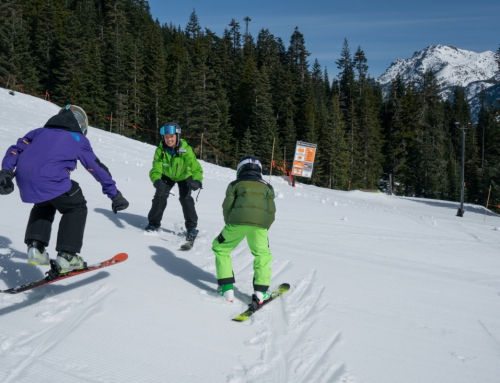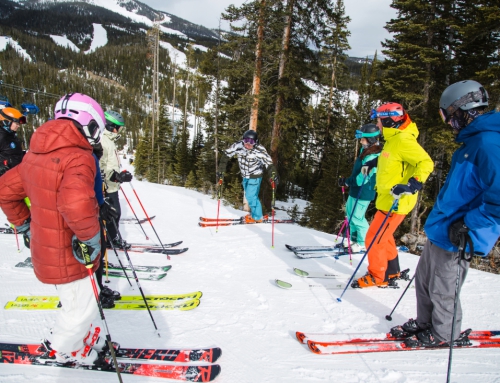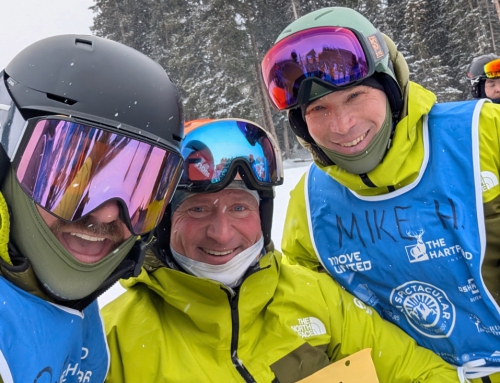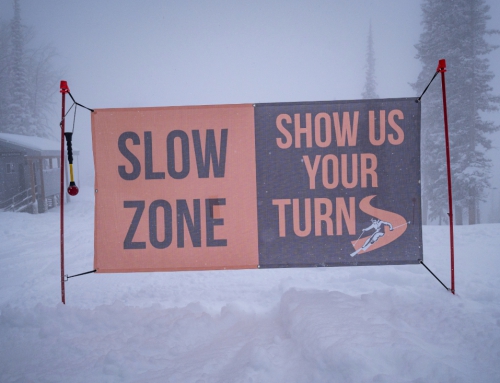The Professional Skier: From the Ground Up, The Psychology of Physiology
This article by Chris Fellows and Darcy Norman first appeared in the 2008 Winter Issue of The Professional Skier, the predecessor to 32 Degrees magazine. You can read the entire issue, packed with timeless information and some ads from 15 years ago, right here.
In the early 1990s, the legendary ski racing coach trying Warren Witherell criss-crossed the country introducing ski instructors to the benefits of balancing boots for optimum ski performance. I remember Witherell swaggering into the Squaw Valley ski school locker room with a roll of
duct tape in one hand and an obscure leg-measuring device in the other. He said he could improve our skiing instantly by tipping our boots laterally in the binding, giving us a positive and direct effect on the ski edge.
Amazingly, he was right. After measuring, eyeballing, and putting various layers and widths of tape on our ski bindings, he had us ski so we could feel how the edge interacted with the snow. It was unbelievable: the skis actually came around easier and held better on firm snow. Witherell said he’d done this somewhat crude form of alignment adjustment for World Cup racers with great results. He really knew how to talk to ski instructors. He also said it might have been the equipment- not the technique or “pilot error”-that had been holding us back. (This gave us another reason to love him.)
After much experimentation with different thicknesses and widths of tape on my bindings, I was convinced and since then I have had my boot soles planed and balanced every season. Witherell’s influence has spread throughout the land, and a cottage industry of custom boot fitting has sprung up due to his book, The Athletic Skier, as well as to his persistence in getting the ski industry to adopt his methods.
But even though many instructors realize the tremendous benefits of making equipment adjustments of just a few degrees, there are just as many who still aren’t taking the time to consider the effects of improper alignment. Before my introduction to Witherell’s boot balancing theories, I was one of them.
Body Language
We often spout the dogma of adopting an athletic stance, proper leg steering, functional pole use, early edging, and a variety of other “instructor-speak” catchphrases. Using the latest drills and exercise lines, we work our students ad nauseam trying to ingrain the “proper skiing moves.” Eventually our students come to believe that a strict diet of these technique drills will deliver them to greatness.
But are we fooling ourselves and our students by believing their troubles can be cured with technique modification alone? Would we see more success if we approached technique improvement from a different point of view? What if we took Witherell’s approach, and measured and tested our students for weakness in their physiology? Then, with a clear picture of what they can do within their own personal limitations, we could design an improvement program with realistic goals for each individual.
After I’d been “Witherell-ized,” the experience kept nagging at me as I watched student after student fail when I started by asking students to perform fundamental movements such as a basic squat, a lateral lunge, and balancing on one leg. As I expected, many of them had great difficulty performing these simple tasks on a flat cafeteria floor. After toying with Witherell’s ideas and my own observations for some time-with students, other instructors, and anyone else who’d listen-I decided to enlist the services of my friend and athletic performance consultant Darcy Norman.
As a ski pro you take pride in having a sharp eye that can scan the body for inefficient movements that may be affecting technique. After a few workouts and conversations with Darcy, I realized I had been missing an important piece in my on-hill assessments: the role of indoor movement testing to help solve various flaws in a student’s technique. Darcy’s expertise in this subject area, combined with my focus on skiing technique alignment, would give me the potential to help my students make real strides in their skiing performance.
We knew that some students would balk at the logistics and expense of involving a certified athletic trainer in their lesson but that most would want to pursue this avenue once they realized its value. After all, a boot-customizing session may cost anywhere from $250 to $750-why not pay $50 to test whether the body is capable of making “the proper moves” for athletic skiing? After I had skied with the group for awhile, Darcy and I would spend about an hour with them doing basic movement screens. (Having observed several full screens, I now feel confident assessing students myself and can easily absorb that cost into the regular lesson fee.) That information provided a complete picture of what each student needed to address physiologically as well as in customized boot balancing.
I soon started to send students away with homework. I prescribed a series of exercises they could do on their own that addressed their mobility, stability, and power issues-all complementing the on-hill technique work. The students who “did their homework” developed much better body awareness and were able to make the on-snow changes almost instantly. Those who neglected to incorporate these exercises into their routine made slower progress. Many within the latter category explained that they already had a “workout routine” they were quite happy with. I encouraged them to just begin to supplement their workouts with a few extra reps of our prescribed drills, knowing that the new movements would at least give them some basic body awareness.
Here is an overview of the approach Darcy and I developed (and continue to use) to measure in a quantitative way the physical barriers that block students from achieving their potential in skiing.
Pyramid Performance Model
To assess a person’s movement quality, Darcy and I use a “performance pyramid” as our model. We developed this pyramid based on concepts in Gray Cook’s Athletic Body in Balance, an excellent resource on the subject of movement and conditioning. The pyramid is made up of three levels that represent an important cause-and- effect dynamic in skiing: functional movement, performance, and sport skill, respectively.
The bottom level of the pyramid represents the skier’s functional movement patterns, that is, his or her mobility and stability. This level serves as the foundation for the next two levels. Performance and skill cannot happen unless the student can display functional movements in a controlled environment.
The middle level represents the skier’s performance, or movement efficiency. These are the movements that enable the skier to produce and absorb power as well as generate the endurance and ability to handle challenging snow and terrain.
The top level represents the skier’s sport skill, or skiing technique. As instructors, we spend most of our time focusing on this area of our student’s development.
Optimal skiing performance is the result of a stable pyramid, that is, one in which the student has consistently strong characteristics at each level. Functional movements support performance and the ability to generate power, which leads to skill and technique. If any of these areas are out of sync, problems will arise.
Using the pyramid sequence, we begin by evaluating students on their functional movements. We use an adaptation of what is called the Functional Movement Screen (FMS), which is described on www.functionalmovement.com, a website developed by exercise and movement physiologists Gray Cook and Lee Burton. Our adaptation of the FMS consists of a basic squat, lateral lunge, single leg squat, and rotary; stability test. Essentially, this test is designed to assess the body’s ability to perform basic movement patterns on stable ground with no sensory challenges. (In the context of skiing, that includes steep slopes, variable snow conditions, flat light, etc.) From this we can determine how well a person moves in a variety of different planes. If the individual does not move well or exhibits any left- or right-side asymmetries during the test, we can draw parallels with what we observe on the ski hill.
In addition to helping us identify specific asymmetries or limitations, the movement screen led us to conclude that most students can be placed into one of four categories: 1) overpowered- students who are strong and tend to use brute muscle power to get the job done (fig. 2); 2) underpowered-students who use their range of motion and elasticity to meet the on- snow challenges (fig. 3); 3) underskilled-students who have a good balance of power and mobility/stability but who need more skiing mileage to fully realize their ability (fig. 4); and 4) the combo platter-students who fall in the gray area between two of the other types.
Placing students into these categories has helped us customize drills and exercises that address a student’s total performance rather than just his or her technique. The homework (or “dryland solution” as we like to call it) gives students a way to practice and visualize skiing technique when they aren’t on snow. This is always good, because the more we can prompt people to think about these concepts, the more ingrained those concepts become. Also, this total approach encourages students to become more aware of proper body alignment, which helps reduce their risk of injury and keeps them skiing longer!
Movement Analysis
The following is an example of how a specific functional movement assessment relates to skiing movement analysis.
Basic Squat
From our screenings we’ve determined that one of the most common movement faults becomes apparent when a person performs a basic squat. When doing this basic exercise, many people struggle to move through the hips properly, largely because they fail to apply proper compensatory movement of the lower body or spine. Instructors see this all the time, particularly in those students who can’t seem to “flex” evenly through their joints. As a result, they tend to bend forward or overflex their ankles or knees, and that causes them to “camp out” over the front of their skis. When watching someone do a basic squat, look for the following clues.
When the student does three consecutive squats, do the legs and knees collapse (angle in or out sharply) each time? Do the knees stay aligned while flexing? Do the feet overpronate and rotate outward? Does the person flex through the spine? These are instant clues that the student may have trouble performing the dynamic on-snow tasks of your lesson plan (e.g., upper-end carving drills, one-legged skiing, fall-line hop turns, and high body-angle drills such as “outriggers”). If the student cannot perform a one-legged balance exercise in the lodge, he or she could have problems with a one-legged skiing drill.
Ideally, the student can keep the spine neutral while flexing through the hips, knees, and ankles. As Warren Witherell so memorably demonstrated, the center of knee mass must be properly aligned as the skier flexes in the boots so the individual can apply direct pressure and energy transfer movements down to the ski.
This and other visual data gleaned from the FMS can provide a specific and very telling snapshot of a person’s movement through the joints, undaunted by the variables of a ski run. If students can demonstrate the ability to perform functional movements smoothly and efficiently, they have the potential to incorporate those movements into skiing. On the other hand, if they reveal movement asymmetries or limitations in the lodge, invariably they will experience certain limitations on the hill.
You can also conduct these basic evaluations on snow as long as you do so on a flat, packed-out area. Start by asking your student to lay on his or her back and pull the knees up to the chest. If the person can do this without difficulty, he or she may have adequate movement through the hips. You can test further by gently pushing the individual’s knees even closer to the chest. If the joints seem supple and glide easily, hip mobility probably will not be an issue.
If at any time the student’s back arches or the movement feels stuck or jammed, immediately stop pushing. This reaction provides clues as to what you might see on snow. Examples include breaking and bending excessively at the waist due to stiffness in the hip flexors, the inability to seat evenly through the hips, knees, and ankles, and rotation of the upper body into the turn due to the student’s inability to twist the legs independently of the upper body.
Finally, have the student unbuckle the top of his or her boots and do a basic squat. As the individual moves, look for the compensation movements described previously and add this information to all the data you are collecting to build your on-hill lesson plan.
This isn’t as hard as it may sound. Your goal is to set the student up for success, not over-complicate things. This information should help you devise solutions that might not have occurred to you otherwise.
Solutions
Once you’re armed with all of this valuable information it’s time to ski. Allow sufficient time for your student to relax and enjoy the mountain, but be sure to watch how the individual makes movement adaptations when faced with terrain challenges. By matching the student with terrain that’s appropriate for his or her ability level, you can provide coaching on effective tactics and help the person make the connections between technical movements both on and off the snow. That is how you complete the teaching circle for success: by helping your students develop better awareness of their own alignment-skiing movement relationships.
At the end of the lesson, the solutions to any weaknesses you’ve identified-along with the next step in the student’s development-should be very clear. Every lesson should end with three “prescriptions:” one for technical (on-snow) drills, one for corresponding dryland drills that address any weak- nesses revealed during the screening, and one for any recommended equipment modifications.
At the risk of stating the obvious, always remember that the functional movement screen is merely a tool that is used to enhance the lesson outcome. While any ski instructor can use the FMS to supplement on-hill movement analysis, it’s important to focus on the connection with skiing improvement-the real crux of any ski lesson.
Warren Witherell just scratched the surface of movement analysis with his ideas about leg alignment; undoubtedly there is much more to be learned on the subject. Instructors and performance coaches should follow Witherell’s lead and study the relationships between exercise science and skiing. (There are numerous resources to support that endeavor, and instructors should seek them out, including various PSIA materials, U.S. Ski Team materials, and non-industry sources such as the Functional Movement Screen.)
The system described in this article can help you measure in a quantitative way the physical barriers that may be blocking your students from achieving their potential. Try incorporating it into your next analysis of a student’s overall setup so you don’t end up glossing over the most amazing piece of equipment of all, the human body.
Chris Fellows is the founder and director of the North American Ski Training Center in Truckee, California, a former member of the PSIA Alpine Team, and co-author of Fitness for Skiing and Snowboarding.
Darcy Norman is the performance director for the Tahoe Center for Health and Sports Performance in Truckee, California. He is a former FIS and college ski racer.







